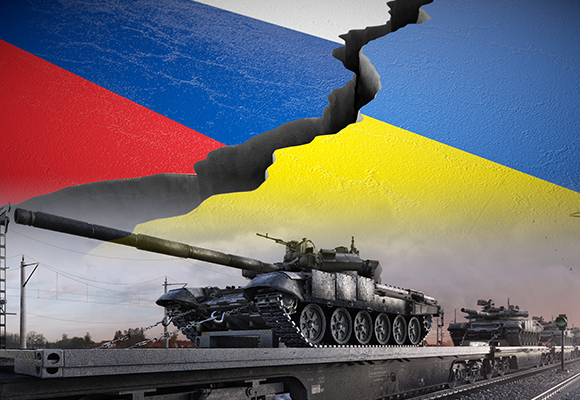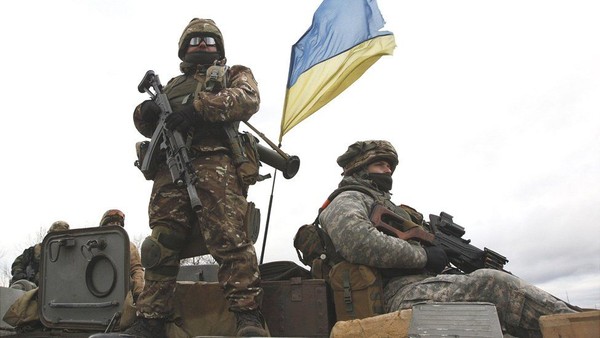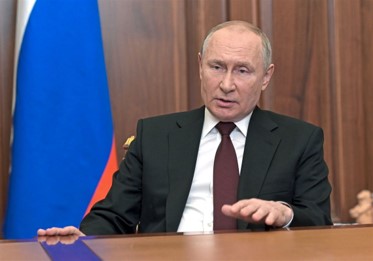On February 24th, Russian President Vladimir Putin announced military operations in Donbas of Ukraine, which is controlled by Pro-Russian rebels, and invaded Ukraine. Meanwhile, the Associated Press (AP) on the same day, citing his words, reported that if there is a state that interferes with Russia they would face "consequences you have never seen." Russian forces even fired missiles in the northern part of the capital, Kyiv. On February 27th, United Nations High Commissioner for Refugees (UNHCR) announced that about 368,000 Ukrainian refugees had arrived in Poland, Hungary, and Romania after the Russian invasion. Russia's invasion of Ukraine, which the world had known was coming, has become a reality. Since when and why did this invasion come to be, and how did it affect international society?

The Background of Ukraine-Russia Crisis: Crimea & Donbas
Ukraine Could Not Meet True Independence: Crimea
Ukraine gained independence when the Soviet Union collapsed. Currently, it shares borders with both EU member states and Russia, but traces of Russia remain in Ukraine's society and culture as a result of its history under the rule of the Soviet Union. Russian is also actively spoken in Ukraine. From March 2014, Russia and Ukraine continued to confront each other due to the annexation of Ukraine's Crimean Peninsula and the civil war in Donbas that began that year. Crimea is a strategic point connecting southern Ukraine to the Black Sea and was a Russian territory until it was incorporated into Ukraine in 1954. In 2014, voices calling for independence from Ukraine grew louder in Crimea, where about 60% of the total population at the time was Russian. As a result, on March 11th of that year, the Republic of Crimea was established. On the 16th, a referendum was held in Crimea to decide Russia's annexation of Crimea, with 96.8% of the residents in favor. As President Vladimir Putin signed the annexation document ten days later, the Republic of Crimea became part of Russia. Ukraine and Western countries have yet to recognize the annexation, citing that the referendum is illegal, is against the Ukrainian constitution, and had been under pressure from Russia. On the other hand, Russia continues to claim ownership of Crimea.
Pro-Russian Region in Ukraine: Donbas
Another element of conflict between Russia and Ukraine is Donbas. Donbas is a geographical name for the Luhansk and Donetsk provinces of Ukraine. It is located in eastern Ukraine and borders Russia. Since 2014, civil wars between pro-Russian rebels in Donbas and Ukrainian government forces have continued. The background of the civil war is the confrontation between pro-Russian and pro-Western forces in Ukraine. In 2013, during the pro-Russian regime, pro-Western forces staged anti-government protests, which overthrew former president Victor Yanukovych and established a transitional government. Then, when Russia annexed Crimea in March 2014, protests by eastern pro-Russian forces against Ukraine's pro-Western regime were still ongoing. Ukraine strongly protested Russia's annexation of Crimea and strongly oppressed protests caused by pro-Russian and separatist forces in the eastern region. However, the pro-Russian Donbas regions, Luhansk and Donetsk, did not yield to government pressure and this led to civil war. In May 2014, Luhansk and Donetsk sought to separate from Ukraine. The Donbas region, through its own referendum, established the Luhansk People's Republic (LPR) and the Donetsk People's Republic (DPR). The two self-proclaimed separatist regions have not yet been recognized by the international community as of the writing of this article, and the Ukrainian government forces have classified them as rebels. Armed clashes between the Donbas region claiming autonomy and the Ukrainian government continued.

Thus, in September 2014, through the arbitration of the Organization for Security and Co-operation in Europe (OSCE), Ukraine, LPR, DPR, and Russia supporting LPR and DPR signed a ceasefire agreement in Minsk. This is the Minsk Protocol. However, after the agreement failed to stop clashes between the Ukrainian government and rebels, leaders of Germany, France, Russia, Ukraine, LPR, and DPR gathered to come to an agreement on Minsk II. On February 12th, 2015, after 16 hours of negotiations, Minsk II was signed with 13 clauses including “Pull-out of all heavy weapons by both sides” and “Immediate and full ceasefire.” After that, the effect was also shown, such as the withdrawal of heavy weapons from the Donbas area. Unfortunately, most of the provisions of Minsk II, which did not specify the punishments of non-compliance, have not been followed and armed conflicts have continued in Ukraine. The casualties that have occurred since 2014 are also significant. In January of this year, the Office of the UN High Commissioner for Human Rights (OHCHR) announced that “The Donbas war claimed the lives of more than 14,000 people, including approximately 3,000 civilians, and injured more than 7,000 civilians.” The LPR and DPR, which are rebel forces for Ukraine, are currently receiving military support from Russia. Hundreds of thousands of Donbas residents have Russian passports, and The Guardians have also analyzed that Russia effectively controls the two regions. In other words, as Ukraine continues its civil war, the conflict with Russia deepens. In fact, Russia, which has supported pro-Russian rebels in the Donbas region, has argued that if the Ukrainian government's attacks on Donbas continue, this could be a justification for the invasion of Ukraine.

Another Reason for Conflict, NATO: Why Is It Controversial Now?
Meanwhile, the conflict worsened as Ukraine made an active move to join the North Atlantic Treaty Organization (NATO). NATO is a political and military alliance of 29 countries in Europe and North America. As Eastern European countries joined NATO after the collapse of the Soviet Union in 1991, Russia started to border some NATO members, namely Western countries, and felt a threat to security. Ukraine currently wants to join the European Union (EU) or NATO to participate in political/economic activities as a member of European countries and ensure national security. Ukraine's will to join NATO was strengthened when Russia invaded Ukraine's territorial sovereignty by annexing Ukraine's Crimea in 2014. After the pro-Russian forces in Ukraine were overthrown and a pro-Western regime took over, the EU took a positive stance toward accepting Ukraine. The EU provided support for Ukraine's democratization and economic development by signing the European Union-Ukraine Association Agreement and Free Trade Agreement (FTA) with Ukraine. In February 2019, Ukraine has amended its constitution and stipulated its main goal of joining NATO and the EU. However, Russia strongly opposes the westernization of Ukraine. Furthermore, they have strongly demanded the ban on Ukraine's accession to NATO and the cessation of NATO expansion, arguing that NATO is threatening its security. In fact, NATO's influence was limited to North America and Western Europe when it was founded in 1949. But over the past 70 years, it gradually expanded to Eastern Europe, moving more than 1,000 km in the direction of the Russian border.

However, it is not recent that Ukraine has expressed its intention to join NATO. After gaining independence from the Soviet Union in 1991, Ukraine has been pursuing NATO membership since the mid-2000s. So, why is Russia increasingly opposed to Ukraine's accession to NATO in recent years, and what can it gain from the Ukraine crisis? On February 22nd this year, the Word Street Journal (WSJ) highlighted that President Putin is working to prevent NATO's expansion and wants NATO to reduce its military force to 1990s levels. Meanwhile, Ukraine borders Russia and has served as a buffer zone between Eastern Europe and Russia. In addition, Ukraine has the largest territory in Europe except for Russia, is the world's largest wheat producer, and is a country with high science and technology. This is an insight into why Russia continues to maintain its influence in Ukraine. As a geopolitical location, this country is essential to maintaining and strengthening Russia's status as a great power. With a high level of coercion, Russia is showing that it is itself that holds the key to the security issues in Europe and the Atlantic that the NATO alliance encompasses. Moreover, the current Russia-Ukraine crisis can serve as an advantage for Russia, which believes that Western countries including the United States have led the international situation against their country after the collapse of the Soviet Union. Correspondingly, Russia deployed about 150,000 troops to the Ukrainian border and demanded that the U.S. ban Ukraine's accession to NATO. The U.S. rejected Russia's request and sent troops to NATO countries adjacent to Ukraine. In the face of the crisis that would put it on the battlefield and the constant threat from Russia, Ukraine took a step back. On February 14th of this year, Ukrainian President Volodymyr Zelensky said about joining NATO: “How much should Ukraine go on that path? Who will support us?” Two weeks later, he officially requested the EU to allow Ukraine to join to defend itself from a Russian invasion. And on March 7th, the EU announced that it would start reviewing Ukraine’s request. Whether Ukraine will succeed in joining is still an issue.
Response of Other Countries and Influence Shown in International Society

Before Russia’s invasion of Ukraine, the concern about the food crisis increased. The International Grains Council (IGC) ranked Ukraine as the world's 4th largest wheat exporter in 2021-2022. This country is the world's largest exporter of grain, and it also plays an important role in global food security by supplying large quantities to developing countries. As Ukraine's conflict with Russia intensified, grain prices began to fluctuate. Right after Russia’s invasion on February 24th, James Wither, Chief Executive of Scotland Food & Drink said on social media, “Be in no doubt, this is a dangerous day for global food security & food prices too, with humanitarian risks that stretch far and wide.” Meanwhile, countries around the world began to directly sanction Russia's invasion of Ukraine. On February 26th, the leaders of the U.S., France, Germany, and more. announced in a joint statement that they would block Russian banks from Society for Worldwide Interbank Financial Telecommunication (SWIFT). SWIFT is a secure message system for quick cross-border payments and smooth international trade. All international transactions such as overseas remittances and deposits have been cut off, making it difficult for Russia to receive normal oil and other export payments. In the international community, SWIFT sanctions, which were called the “financial nuclear option.” have been applied only to Iran and North Korea. As a result, the Russian financial market became unstable as the value of the Russian ruble fell to an all-time low in the Asian market, and Russians rapidly bought the Dollar. Meanwhile, Sweden announced on February 27th that it would provide arms to Ukraine, breaking its national policy of not supplying arms in international conflicts. Similarly, on the 28th, the Korean government decided to provide emergency aid worth 10 million dollars to help the Ukrainian government, its people, and refugees.
Russia and Ukraine are experiencing a deep conflict as they share a long history. Numerous political and social interests exist between the two countries, such as the history of the Soviet Union, Crimea, and Donbas. The conflict between the two countries even involved NATO allies, which had a profound impact on the world. And on February 24th, when Russia invaded Ukraine, tragedies such as Ukrainian reserves being mobilized in battle and even children trembling in fear in bunkers occurred. Four days after, the two countries held talks on the continuation of the war or a ceasefire. It is hoped that Russia and Ukraine will quickly settle their positions so that the international community and citizens’ life can go back to normal.

